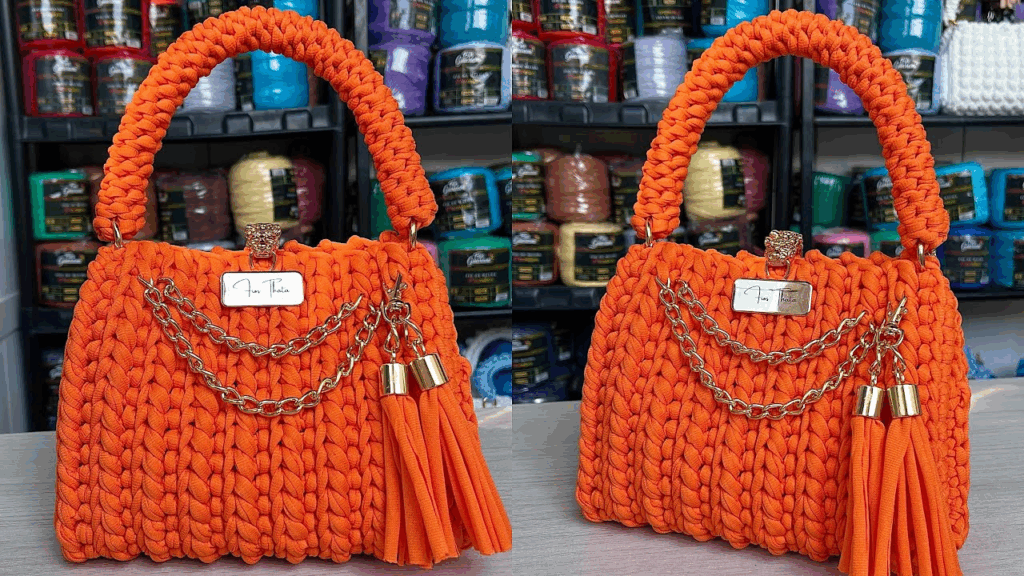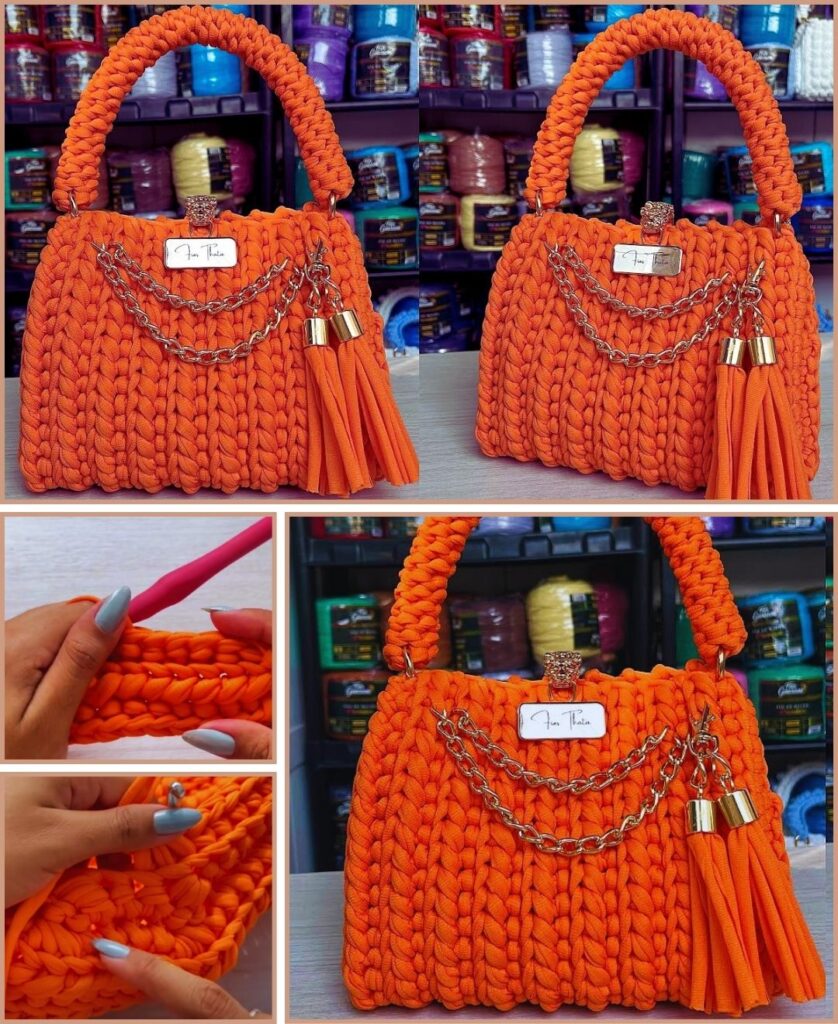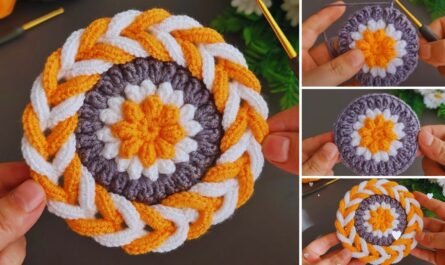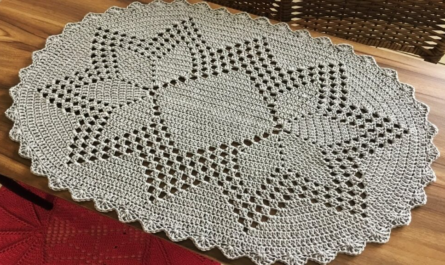Making a crochet tote bag is a fantastic and rewarding project! It’s super practical, endlessly customizable with colors and stitches, and a great way to show off your crochet skills. For a sturdy and long-lasting tote, especially in a warm climate like Phnom Penh, 100% cotton yarn or a cotton blend is definitely the best choice. It offers excellent durability, holds its shape well, and has beautiful stitch definition.
This detailed tutorial pattern will guide you through creating a classic, rectangular crochet tote bag using single crochet stitches for a dense, strong fabric.

How to Make a Crochet Tote Bag
This pattern is designed for a medium-sized tote, perfect for everyday essentials, groceries, or a trip to the market.
1. Essential Materials You’ll Need
- Yarn:
- Fiber: 100% Cotton or a Cotton Blend (e.g., 80% Cotton / 20% Acrylic). These materials are durable, have minimal stretch, and are easy to wash.
- Weight: Worsted Weight (Aran / Medium / 4) is ideal for a sturdy tote.
- Colors: Your choice! You can use one solid color, or two or more colors for stripes (if using stripes, refer to previous advice on color changes). For a solid bag, you’ll need about 500-700 yards (450-640 meters).
- Crochet Hook: A 4.0mm (US G/6) or 4.5mm (US 7) hook. The key is to achieve a tight tension so your bag is firm and holds its shape without sagging. If your stitches look loose, go down a hook size.
- Scissors: For cutting yarn.
- Yarn Needle (Tapestry Needle): Essential for weaving in all your ends neatly and securely.
- Stitch Markers (Optional but Recommended): Very helpful for marking the beginning of rounds and handle placement.
2. Basic Crochet Stitches You’ll Use
This tote bag relies on just a few fundamental stitches:
- Chain (ch): To start your project and create handle loops.
- Slip Stitch (sl st): For joining rounds.
- Single Crochet (sc): This is the primary stitch for the bag’s body. It creates a dense, sturdy fabric that’s perfect for a bag.
- Back Loop Only (BLO) (Optional): Working into only the back loop of a stitch can create a subtle ridge, which is great for defining the base from the sides of the bag.
Part 1: The Base of the Bag
We’ll start by creating a flat, oval-shaped base, which provides a nice foundation for your tote.
Abbreviations (US Crochet Terms):
- ch: chain
- sc: single crochet
- sl st: slip stitch
- st(s): stitch(es)
- Rnd: round
- BLO: back loop only

Instructions for Bag Base (Using your main bag color):
- Starting Chain:Ch 31.
- This chain length will determine the length of your bag’s base. For a smaller bag, chain fewer stitches (e.g., 21-26). For a larger bag, chain more (e.g., 36-41). Always keep your starting chain an odd number for symmetrical increases.
- Rnd 1: Work 2 sc into the 2nd ch from hook. Sc in each of the next 28 ch. Work 4 sc into the last ch. (You’ve now turned the corner and are working along the opposite side of the starting chain). Sc in each of the next 28 ch. Work 2 sc into the very last ch (this completes the second corner). Join with a sl st to the first sc. (64 sc total)
- Rnd 2: Ch 1 (does not count as a st). Work 2 sc in the first st. Sc in each of the next 30 sts. Work 2 sc in the next st. Sc in each of the next 30 sts. Work 2 sc in the last st. Join with a sl st to the first sc. (68 sc total)
- This completes a slightly wider, flatter base. If you want an even wider bottom for your tote, you can add more rounds to the base. Each additional round would involve increasing by 4 stitches (2 at each “corner” of the oval) and would follow the pattern of (sc in X sts, 2 sc in next st) for the straight sections.
Part 2: The Body of the Bag
Now, we’ll build up the sides of your tote bag. We’ll work in continuous rounds, joining with a slip stitch at the end of each round for a clean finish.
- Rnd 3 (First Side Round): Ch 1 (does not count as a st). Work 1 sc in the BLO (back loop only) of each st around. Join with a sl st to the first sc. (68 sc)
- Working in the BLO for this round creates a subtle, defined ridge that helps the bag “turn the corner” from the flat base to the upright sides. It gives a nice, crisp transition. This step is optional but recommended.
- Rnd 4 and onwards: Ch 1 (does not count as a st). Work 1 sc in each st around. Join with a sl st to the first sc. (68 sc)
- Repeat Rnd 4 until your tote bag reaches your desired height. A typical tote bag might be 12-14 inches (30-35 cm) tall, but adjust this to your preference.
- If you’re making stripes, this is where you’d implement your color changes as discussed previously (change color on the last sl st of the round).

Part 3: Adding the Handles
We’ll create simple, integrated loop handles directly as part of the bag’s top edge. This makes them very sturdy.
- Handle Placement (Using the color of your last stripe, or your main bag color):
- Once your bag body is tall enough, lay it flat and determine where you want your handles. You have 68 stitches around the top edge. We’ll divide these to create two handles.
- A good starting distribution for handles on a 68-stitch top circumference:
- Front/Back Panels: 10 sc stitches at each side of the bag (total 20 stitches).
- Handle Openings (skipped stitches): 14 stitches for each handle opening (total 28 stitches).
- Top Middle Section (between handles): 20 sc stitches.
- Check: 10 (front) + 14 (skip) + 20 (middle) + 14 (skip) + 10 (back) = 68 stitches.
- Rnd (Handle Prep): Ch 1 (does not count as st).
- Sc in the first 10 sts.
- Ch 28 (This forms your first handle loop. Adjust this chain length to make your handles longer or shorter – test it out by holding the chain up!).
- Sk 14 sts (skip these 14 stitches on the bag body – this is the opening for the handle).
- Sc in the next 20 sts.
- Ch 28 (This forms your second handle loop).
- Sk 14 sts.
- Sc in the remaining 10 sts.
- Join with a sl st to the first sc of this round.
- Rnd (Handle Finish/Reinforcement): Ch 1 (does not count as st). Work 1 sc in each sc around the top of the bag. When you reach a chain-loop handle, work 28 sc evenly into the chain loop (aim for 1 sc per chain, or slightly more if needed to keep it flat). Continue working 1 sc in each sc of the bag body and 1 sc in each chain of the second handle loop. Join with a sl st to the first sc.
- This round solidifies the handles. You can repeat this round one or two more times if you want really thick, sturdy, and comfortable handles.
4. Finishing Your Tote Bag
- Fasten Off: Once you’re happy with your bag, cut your yarn, leaving a tail of about 6-8 inches (15-20 cm). Yarn over your hook, pull the tail completely through the loop, and pull tight to secure.
- Weave in All Ends: This is a crucial step for a neat, durable bag. Use your yarn needle to carefully weave in every single yarn tail. Go back and forth through stitches on the inside of the bag, making sure they are well hidden and secure. Take your time here – securely woven ends prevent unraveling.
- Optional Lining: For added durability, structure, and to prevent small items from slipping through stitches, consider sewing a fabric lining into your crochet tote bag. This is especially useful for bags that will carry heavier items or in a humid climate, as it helps the bag maintain its shape and offers extra protection. You can hand-sew it in using a regular needle and thread.
- Blocking (Optional): While cotton bags hold their shape reasonably well, you can gently steam block your bag to even out the stitches and shape it perfectly. For cotton, you can also wash it according to yarn instructions, then stuff it with towels or newspaper to hold its shape as it air dries.

Tips for a Wonderfully Made Tote Bag
- Consistent Tension: Maintaining an even, firm tension is vital for a bag that stands up well and holds its shape. If your bag feels too floppy, try going down a hook size.
- Stitch Markers are Your Friend: Use them to mark the beginning of each round, especially if you find your seam shifting. They are also invaluable for accurately placing your handle openings.
- Customization is Key: Don’t hesitate to adjust the starting chain length for a wider/narrower bag, or the number of body rounds for a taller/shorter bag. You can also play with handle length by chaining more or fewer stitches.
- Yarn Choices: While cotton is great, for extra stiffness, some crocheters like to hold two strands of worsted weight yarn together while crocheting, or use a slightly smaller hook than recommended for the yarn.
You’ve now got a detailed pattern to create a fantastic, functional, and stylish crochet tote bag! Enjoy the process of bringing your unique bag to life.



